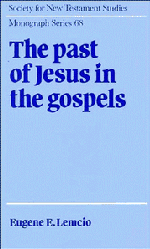Book contents
- Frontmatter
- Contents
- Acknowledgments
- List of abbreviations
- 1 Introduction: faith, kerygma, gospels
- 2 Mark
- 3 Matthew
- 4 Luke
- 5 John
- 6 Summary and implications
- Appendix The unifying kerygma of the New Testament
- Notes
- Bibliography of works cited
- Index of biblical references
- Index of modern authors
- Index of subjects
- Frontmatter
- Contents
- Acknowledgments
- List of abbreviations
- 1 Introduction: faith, kerygma, gospels
- 2 Mark
- 3 Matthew
- 4 Luke
- 5 John
- 6 Summary and implications
- Appendix The unifying kerygma of the New Testament
- Notes
- Bibliography of works cited
- Index of biblical references
- Index of modern authors
- Index of subjects
Summary
Introduction
With Luke, the contrasts which I have been underscoring could be made more easily by an appeal to Acts. Here, the post-Easter life of the church as he interpreted it meets us with clarity and force. However, I shall avoid this natural move, since the point of the entire exercise has been to rely upon internal evidence exclusively. And an abundance of it exists in chapter 24: except for John, the most extensive account of Jesus' post-resurrection activity in the gospels. As with Matthew, I shall use this material to provide the major sections and sub-categories for the data. Finally, the Prologue will contribute its special brand of evidence to the argument.
Post-resurrection narrative (24:13–53)
On the road to Emmaus
The two men whom Jesus joined on the journey are otherwise unknown, belonging to the outer circle of disciples (the πᾶσιν τōῖς λōιπōῖς of v.9; cf. v.33b). Yet Cleopas and his partner are inside enough to refer to “some of our women” who brought them the startling reports of the risen Jesus (v.22). Likewise, the contingent of men who subsequently inspected the site are called “some of those with us.” Their reactions afford a further insight into the pre-Easter mindset among the band of disciples. Through his miracles and preaching, Jesus had reminded them of Yahweh's historic spokesmen.
“A man, a mighty prophet” (v. 19)
Not yet enlightened with the supreme estimate of the risen Lord, these two reflect what the earthly Jesus had said of himself.
- Type
- Chapter
- Information
- The Past of Jesus in the Gospels , pp. 74 - 90Publisher: Cambridge University PressPrint publication year: 1991



